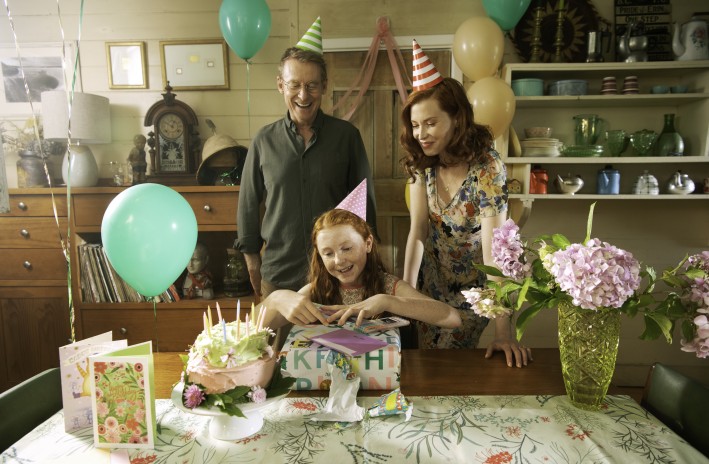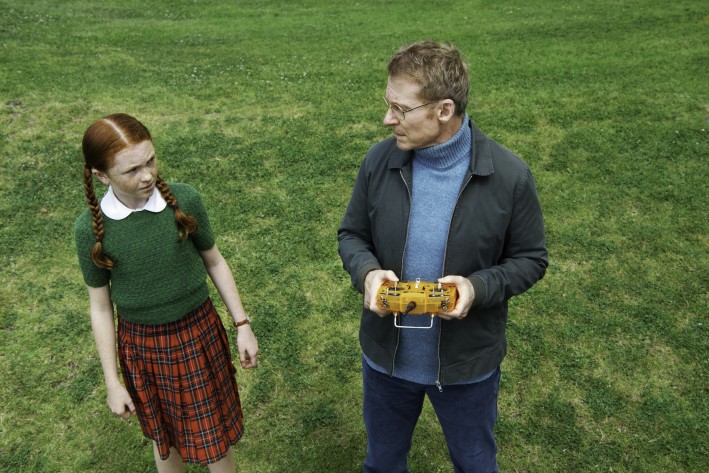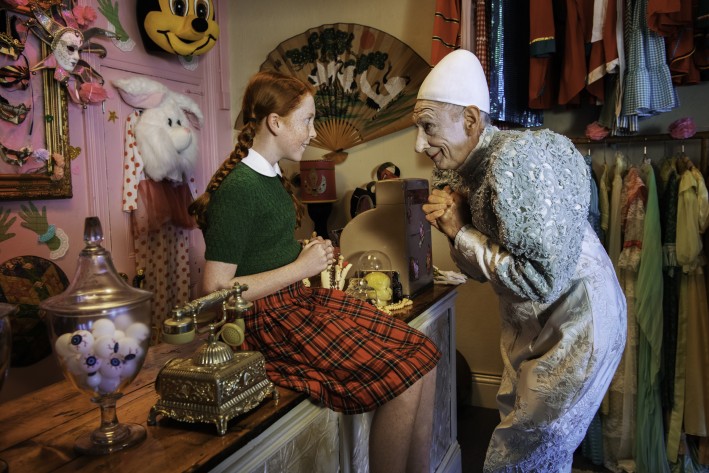An interview with John Sheedy, director of 'H is for Happiness.'
BUNJIL PLACE:
Hi John, thanks for joining us today. You’re an acclaimed director of a number of theatre productions, including Driving Into Walls, Storm Boy, Jasper Jones, The Rabbits. H is for Happiness was your first time directing a feature film. How does directing film compared to directing theatre?
SHEEDY:
Well, there's obviously similarities in terms of, you know, storytelling, directing performance, and hitting those emotional dates to tell a story. It's a visual world, so I guess the crossover from film has many areas that it's a skill set that's easily transferable. But in turn, there's a whole new vocabulary, you have to really learn, you know, or technical aspects. So, there was a bit of a catch up to be heard around that.
And of course, you know, just learning how to hit those moments and tell a story with a camera. And I found that process really fascinating. It was really, really enjoyable but I kind of hit the ground running really. I did direct a short film called Mrs McCutcheon before I made H Is for Happiness, so I had kind of had a some insight but, you know, it's an ever evolving and learning process that I’m really enjoying.
BUNJL PLACE:
Were there elements of theatre directing that you helped you with the directing the feature film?
SHEEDY:
Yeah, absolutely. Directing actors, performance and performance level, and what's important to show in each scene, what is the information we need to get? What is the emotional under current that we need to draw up? So, that is definitely a skill set that one can draw on from spending years, working with actors, whether it's on stage, whether it's on film or television. So, I definitely brought that element into it I guess that playfulness that actors do in theatre as well, that can transfer to the screen. So, it was enjoyable to be able to bring that across.
BUNJIL PLACE:
You’ve spoken before about a ‘heightened view' that you wanted to bring to the film. Tell me a bit more about what this means and how you achieve this?
SHEEDY:
Well, I guess when you look at the color palette, when you look at the quirky characters in the town, when you look at the visual design of the world, something that, you know, obviously we focus on a lot in theatre. And so of course, it's visual storytelling in film and television, it's all the same, but it's, heightened. It's a little bit bigger in theatre, of course.
I mean, it's all told through the eyes of a 13-year-old girl who has a quirky way of interpreting the world around her and the people around her. So, it does have a slightly heightened style to it, which you can do in theatre, which lent itself to the tone of the film in a good way.
BUNJIL PLACE:
The main character Candice’s world exists in three distinct spaces; the school, the town and her home. Can you tell me a little bit more these intentionally separate spaces?
SHEEDY:
Well Candice is in every single same scene, it’s her story, it's her journey. To me, there were very three very clear worlds that she was playing within. And one was, you know, her school which is full of colorful characters and larger than life kind of personalities like a teacher. And then there was the world of the town, which was a fairy quirky seaside town with quirky little locals that she knows all of them, of course. And then there was her home life, which is a place of silence and stillness and grief.
I found that juxtaposition of those worlds really interesting in those three worlds Candice has to navigate. That’s what makes such good drama for me. That’s what I loved about the script was that balance; that's not all color and movement. It's not all joyous. It's not all laugh. It's actually heartbreaking, with some really tough, challenging moments. It was really important to sit in the muck with Candice and feel that with her. Those three worlds were identified pretty clearly and we made sure that we struck a balance across the film.
BUNJIL PLACE:
As a director you have often worked with stories of children and young people; Storm Boy (2013, 2015), Jasper Jones (2014), Mrs McCutcheon (2017). What draws you to tell the story of young characters? What techniques do you deploy to make the story resonate with a younger audience?
SHEEDY:
Absolutely, I mean with young people, things always seem to be a bit bigger. What is a small problem for adults is a big problem to children. And so, it was important to acknowledge that and play that out. Equally not to patronise a young audience by washing over the tougher moments and watering it down, you can't do that. You have to put a lot of trust in a young audience that they'll be able to navigate their way through those tough moments. I think the worst thing we can do is water down those moments then patronise a young audience. So, I've never done that in the works like Jasper Jones, Storm Boy, Driving The Walls and The Rabbits. I mean, you're dealing with big issues; in The Rabbits you’re dealing with colonisation, indigenous culture and stolen generation. In Jasper Jones you’re dealing with racial prejudice and teenage suicide. In Storm Boy you're dealing with grief and loss.
You know, but within that is a beautiful innocence and a playful world. And I guess it's really important to be very truthful and come from a point also be a child you have to go on to your child and look at that problem as an adult and for them actually it's a lot bigger for them than it is for us, you know? And then also be able to have something in there for adults too. It’s really, it's a film for all ages, with universal themes, so to keep on that trajectory and to keep truthful and honest to that. It requires a very fine balance.
BUNJIL PLACE:
Do you work closely with the young actors themselves in terms of their influence in the telling the story as well?
SHEEDY:
Yes, we spent weeks rehearsing so I spent a lot of time with them. I had worked with Wesley Patton before in Mrs. McCutcheon so it was really nice to collaborate with him again on my first feature. There was a lovely journey we had together. We have a natural shorthand dialogue having worked before, . We spent weeks with the two main characters picking through the texts, looking at the moments, you know, exploring the beginning, middle and end. They (Patton and Axon) naturally bring their own things to it. It’s important to allow them to explore, discover, and make offers and accept those offers and let them run with it because they'll bring things that I didn't even think about. And it's from their perspective, so you don't shut that down. You will open the doors wider, you kept the doors wide open for that.
BUNJIL PLACE:
H is for Happiness, is an adaptation of Barry Jonsberg's award-winning 2013 young adult novel My Life as an Alphabet, by screenwriter Lisa Hoppe. What is the process of creating a film that is based on book? Do you read the book to try and capture the original intended essence or do you steer completely away from that to create your own interpretation of the story?
SHEEDY:
Oh, no, not at all. I mean, the screenplay had already been written by the time I was attached as the director. So I wasn't a part of the process of the adaptation from the novel to the screenplay. But I certainly picked the book up and read the book several times and you do want to be truthful and honor the author's voice and the characters. There's an authenticity there that you need to get into the film. I certainly threw myself into the pages and made sure that, you know, Barry's world and characters were represented in the film. And of course, you read into it your own things. The there's also things in the book you can put in the film, you've got to shorten it. So, it was a very respectful and carefully constructed approach to making sure we got all the main themes and central characters and their journey was represented in the film as is in the book.
BUNJIL PLACE:
In 2020 the film was selected for the Berlin Film Festival and also selected to open the Generation K+ segment, and you received a special mention by the Children’s Jury. In 2019 H is for Happiness won the $100,000 CinefestOZ Film Prize.
SHEEDY:
We got the grand prize!
BUNJIL PLACE:
Which is fantastic! What does this type of recognition do for you as a new director of film and your future within that?
SHEEDY:
Well being selected to open the Generation K+ section of The Berlin International Film Festival is a big kind of thing. It’s a good acknowledgement that your work has a place in the international theatrical release and the international festivals. So, that's I guess what it is just a really good acknowledgement that you can create international works that resonate nationally. But that's for everyone too. So, I guess receiving those acknowledgements is great! It’s played at several festivals, it's having a really good run. Which certainly helps with other projects, by being attached to a successful film. So, it's good, nothing but positives from that.
BUNJIL PLACE:
Do you see yourself working more in film or do you think there'll be a bit of a split between film and theatre or you'd just go back to theatre?
SHEEDY:
Now, the focus on is more film and television now. Although I still direct, I am attached to director Opera. I still do that with Opera Australia. There's an interesting theatre project certainly on the horizons but at the moment, the focus is film and television.
BUNJIL PLACE:
Well, thank you very much for joining us today. We are very much looking forward to opening the MIFF Summer Residency with H is for Happiness.
SHEEDY:
Oh, not a problem. Thank you for making the time and for the interview. And I'm very excited that we'll be opening.
H is for Happiness will be opening the MIFF Summer Residency at Bunjil Place this Friday 5th February!
Be sure you book your ticket so you don't miss out!




